从目的论三原则看电影字幕翻译——以《白日焰火》为例
《白日焰火》电影解说文案
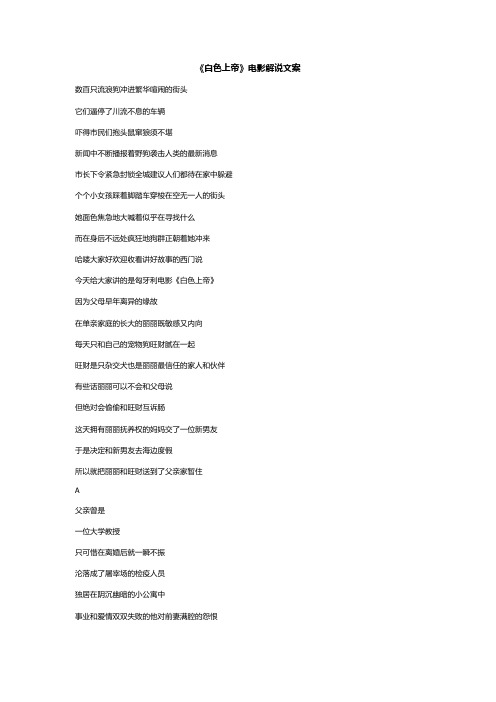
《白色上帝》电影解说文案数百只流浪狗冲进繁华喧闹的街头它们逼停了川流不息的车辆吓得市民们抱头鼠窜狼须不堪新闻中不断播报着野狗袭击人类的最新消息市长下令紧急封锁全城建议人们都待在家中躲避个个小女孩踩着脚踏车穿梭在空无一人的街头她面色焦急地大喊着似乎在寻找什么而在身后不远处疯狂地狗群正朝着她冲来哈喽大家好欢迎收看讲好故事的西门说今天给大家讲的是匈牙利电影《白色上帝》因为父母早年离异的缘故在单亲家庭的长大的丽丽既敏感又内向每天只和自己的宠物狗旺财腻在一起旺财是只杂交犬也是丽丽最信任的家人和伙伴有些话丽丽可以不会和父母说但绝对会偷偷和旺财互诉肠这天拥有丽丽抚养权的妈妈交了一位新男友于是决定和新男友去海边度假所以就把丽丽和旺财送到了父亲家暂住A父亲曾是一位大学教授只可惜在离婚后就一瞬不振沦落成了屠宰场的检疫人员独居在阴沉幽暗的小公寓中事业和爱情双双失败的他对前妻满腔的怨恨但对女儿心中仍然满是怜爱不过当父女二人这次见面时还是发生了一段小小的争吵原因就是那条整日腻在女儿身边的狗常年在屠宰场工作的他双手沾满了动物的鲜血所以他对各种动物都非常地厌恶然而最终还是心软妥协了许久未见的小公主怎能忍心让她难过呢父亲将丽丽和旺财带回自己的单身公寓还没上楼就遭到房东老太太的抱怨表示在这里养狗需要登记还要交钱父亲不想招惹麻烦只得带着女儿赶紧躲进了屋内夜晚旺财被父亲玲进了厕所睡觉可旺财见不到小主人就一直叫个不停丽丽只好拿着自己的小号在厕所里安抚旺财而她自己也在浴缸里睡了一夜清晨睡梦中的父亲被一阵门铃声吵醒来人自称是动物管理局的说是接到举报电话这里有人在养杂交犬他告诉父亲养杂交犬必须要交税否则就得把狗送去犬类收容所原来这又是房东老太太在背后鬼现如今穷困倒的父亲连养活自己和女儿都够呛哪还有更多的钱去为一只狗交税无奈之下父亲不顾女儿反对强行将旺财从车上下来丢弃在路边车子越开越远拼命追赶着的旺财渐渐失去了自标它穿梭在拥挤的车流中迷茫而又无助但它坚信主人还会回来找自己的于是就回到了被丢下的地方但等了许久也没有看到丽丽的身影因为此时的丽丽已经被父亲关了禁闭除了参加合唱团的排练外没有任何出门的机会饥肠的旺财意识到不能一直站在这儿等死凭借着敏锐的噢觉它来到一间生肉铺试图寻找食物不料店内的屠夫却拿着砍刀恶狼狠地向它走来危机关头一只骨瘦磷的斑点狗将旺财从危难之中解救了出来温弧的小斑点将旺财带到一处废这儿挤满了埋头寻找食物的流浪狗第一次见到这么多同伴的旺财也高兴地翘起尾巴加入了它们然而好景不长动物管理局的人发现了这里并开始对着里的流浪狗进行了围捕在逃跑过程中慌不路的旺财不幸和斑点失散关键时刻一位流浪汉把它藏了起来这才使得旺财逃过一劫本以为遇到了一个好心人谁料黑心的流浪汉也是另有所图他一转眼就将旺财卖给了斗狗贩沦落到斗狗贩手中可怜的狗狗就变成了他们赚钱的机器悲惨的命运也就此开始了不仅每天都要被注射各种各样的兴奋剂而且还要接受既残忍性又血腥的训练以生肉为引激发出狗的野性在斗狗场上与同类自相残杀旺财逐渐被训练成了一头恶犬第一次参加比赛时旺财当场咬死了一只同类看着那鲜血淋漓的尸体和翻白的眼珠平静下来的旺财住了它不知道自己为什么会变得如此凶残好斗这时斗狗场内忽然一片黑暗原来是停电了混乱之中旺财头也不回的跑了出去它不喜欢这样的生活更加厌恶这样的自己无家可归的旺财又回到了斑点狗所在的废墟它们相互依着度过了一个电闪雷鸣的夜晚却在隔天再次遭到了动物管理局的抓捕这一次它们不再好运全部都被抓进了收容所等候处理由于旺财的一只前腿在斗狗时受伤收容所的人便将它关进了残狗病狗的笼子打算找个时间一起将它们人道毁灭谁料已经被训练成恶犬的旺财忽然奋力反抗张开血盆大口咬死了收容所的工作人员并带领着笼子中所有的狗逃出了这里它们愤怒地在繁华的闹市中狂奔受到惊吓的人们顿时乱做了一团此时正在舞台上表演的丽丽却是毫不知情很快由旺财带领的狗群就穿过重重阻碍闯进了演奏厅肆意的破坏着这里的一切惊慌之余丽丽忽然发现了旺财的身影她撇下合唱团独自骑车追了出去空荡荡的大街上丽丽焦急的呼喊着旺财的名字一群恶狗从她身后窜了出来硬生生地将自行车挤到而丽丽也重重的摔落在地时间一转眼来到了晚上旺财带领狗群包围了当初的生肉铺将曾经对它挥刀相向的屠夫撕咬致死而后又转多个地方陆续解决了斗狗贩流浪汉以及房东老太太等到丽丽随后赶来时看到的只有一个个血淋淋的命案现场恶狗伤人事件令警方感到十分头疼他们拿起武器开始射杀这些所谓的恶狗当旺财意识到危险准备带领狗群撤退时已经有不少的狗开始中枪倒地这场伤亡惨重的战役激怒了旺财复仇的火焰在狗群中彻底爆发另一边仍在寻找旺财的丽丽意外地遇见了躲藏在角落的小斑点小斑点意识到丽丽是在找旺财于是乖巧地在前方带路但没走多远就被一批全副武装的警察拦住并开枪射杀了无辜的小斑点伤心欲绝的丽丽没了小斑点的帮助只能独自摸索旺财的下落阻止它伤害更多无辜的市民丽丽意识到被旺财杀死的这些人都是曾经直接或间接伤害过它这就表示自己的父亲也在旺财的猎杀名单内于是她赶到屠宰场大声警告父亲不要出门谁料话音刚落旺财就带着狗群冲了过来它牙嘴的冲着丽丽低吼此时的旺财已被仇恨蒙蔽了心智完全认不出曾经的主人了痛心的丽丽难以想象这些天来旺财究竟遭受过怎样的折磨才会变成这个样子她缓缓拿出书包中的小号吹起了熟悉而又动人的旋律音乐声中旺财终于记起美好的过往平静的坐在那里凝望着主人整个狗群躁动的情绪也慢慢平复它们埃个趴在地上对着丽丽示好原来和平竟然如此的简单曲完毕后丽丽也学着它们的样子趴了下来屠宰场的员工问父亲要不要报警父亲拒绝了然后他也微微屈身爬了下去充斥着仇恨的夜晚终将过去人类和狗都将迎来蕲新的黎明愿我们可以和平共处以后的每一天电影《白色上帝》于2014年在夏纳电影节上映导演凯内尔一直对神非常感兴趣而狗的英文写法倒过来就是上这也是导演为什么选择狗做为电影的主题当一个生命掌握其他生命的生杀权时它就被反转成了上帝拍摄过程中使用了创纪录的二百七十四只狗这些狗多数来自于流浪动物救助中心有的时候人类的一个想法就可能终结动物的生命生活在地球上的每一个物种都与我们人类密切相关如果我们怠慢和忽视甚至刻意去伤害乃至消灭它们或许它们就会反过来影响我们的生活乃至生命好了今天的故事就讲到这里吧我是西门喜欢记得关注我么么哒11豆瓣9.4高分,十年以来全球最感丈夫爱妻顾家,妻子为何却执意.狗与人的微妙情感,看完这电影,….。
《2024年从目的论角度浅谈英文电影片名翻译》范文

《从目的论角度浅谈英文电影片名翻译》篇一一、引言电影作为一种全球性的文化传播媒介,其片名翻译的质量对于电影的推广和接受度具有重要影响。
本文将从目的论角度,浅谈英文电影片名翻译的高质量策略与方法。
二、目的论视角下的翻译目的论,作为翻译理论的一个重要流派,认为翻译行为具有一定的目的性。
在英文电影片名的翻译中,目的论为我们提供了重要的指导原则。
翻译的目的是为了让目标语观众更好地理解和接受原作,因此,电影片名的翻译也应以目标语观众的文化背景、审美习惯和接受心理为依据。
三、高质量英文电影片名翻译的特点1. 文化适应性强:翻译后的电影片名应与目标语文化背景相契合,避免文化冲突。
2. 信息传递准确:电影片名应准确传递电影的主题、风格和情感等信息。
3. 吸引注意力:翻译后的电影片名应具有吸引力,能引起目标语观众的兴趣。
四、高质量英文电影片名翻译的策略1. 直译与意译相结合:在翻译电影片名时,应结合直译和意译的方法,既要保留原名的基本信息,又要使译文符合目标语的文化习惯。
2. 借助于文化元素:在翻译过程中,可以借助一些文化元素,如成语、俗语等,使译文更具文化内涵。
3. 创新与规范并重:在追求创新的同时,也要遵循一定的翻译规范,确保译文的准确性和可读性。
五、实例分析以电影《The Shawshank Redemption》(肖申克的救赎)为例,其原名为“肖申克的救赎”,直译过来可能会让观众感到困惑。
因此,在翻译过程中,采用了更具创意和文化内涵的“救赎之路——肖申克的故事”作为译名。
这个译名既保留了原名的基本信息,又具有吸引力,且符合中文表达习惯。
六、结论英文电影片名的翻译是一项复杂的任务,需要我们在目的论的指导下,结合目标语观众的文化背景、审美习惯和接受心理进行翻译。
高质量的英文电影片名翻译应具有文化适应性、信息传递准确性和吸引力等特点。
在翻译过程中,我们应采用直译与意译相结合、借助于文化元素和创新与规范并重等策略,以实现高质量的翻译效果。
从目的论看国产电影字幕中文化词的英译-精选文档
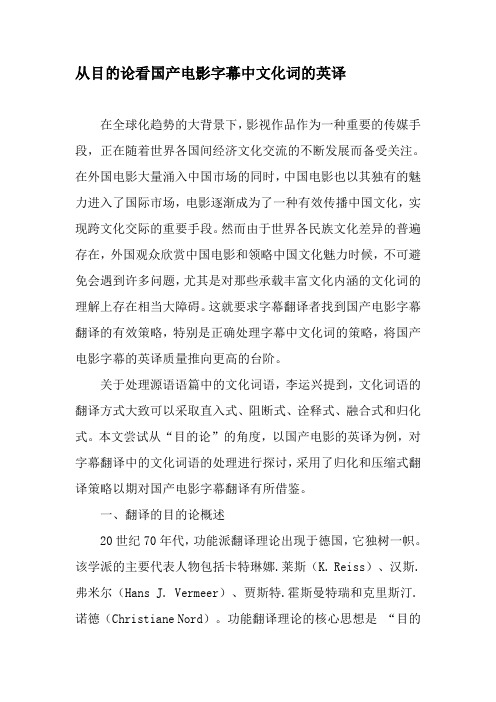
从目的论看国产电影字幕中文化词的英译在全球化趋势的大背景下,影视作品作为一种重要的传媒手段,正在随着世界各国间经济文化交流的不断发展而备受关注。
在外国电影大量涌入中国市场的同时,中国电影也以其独有的魅力进入了国际市场,电影逐渐成为了一种有效传播中国文化,实现跨文化交际的重要手段。
然而由于世界各民族文化差异的普遍存在,外国观众欣赏中国电影和领略中国文化魅力时候,不可避免会遇到许多问题,尤其是对那些承载丰富文化内涵的文化词的理解上存在相当大障碍。
这就要求字幕翻译者找到国产电影字幕翻译的有效策略,特别是正确处理字幕中文化词的策略,将国产电影字幕的英译质量推向更高的台阶。
关于处理源语语篇中的文化词语,李运兴提到,文化词语的翻译方式大致可以采取直入式、阻断式、诠释式、融合式和归化式。
本文尝试从“目的论”的角度,以国产电影的英译为例,对字幕翻译中的文化词语的处理进行探讨,采用了归化和压缩式翻译策略以期对国产电影字幕翻译有所借鉴。
一、翻译的目的论概述20世纪70年代,功能派翻译理论出现于德国,它独树一帜。
该学派的主要代表人物包括卡特琳娜.莱斯(K. Reiss)、汉斯.弗米尔(Hans J. Vermeer)、贾斯特.霍斯曼特瑞和克里斯汀.诺德(Christiane Nord)。
功能翻译理论的核心思想是“目的论”,其宗旨是“目的决定方式和手段”,目的论又包含三大原则,即“目的原则”、“连贯原则”和“忠诚原则”。
其中,“目的原则”是首要原则,也是最高原则,其他两项必须服从它。
“目的原则”是指译文的预期目的或功能决定翻译策略与翻译方法,连贯原则是指译文必须符合“语内连贯”的标准。
所谓“语内连贯”是指译文必须能让接受者理解,并在目的语文化以及使用译文的交际环境中有意义。
此外,还有“语际连贯”,“语际连贯”类似于通常所说的忠实于原文,而忠实的程度和形式则由译文目的和译者对原文的理解决定”(仲伟合、钟钰,1999)“忠诚原则”认为译者在翻译过中一方面要尊重原作者,尽量贴近原文作者意图,另一方面又要对译文的读者负责,尽量符合他们的口味,在协调目的语读者和原作者关系之间达到一种平衡(贾文波,2004)。
《2024年从目的论的角度讨论英语电影片名翻译》范文

《从目的论的角度讨论英语电影片名翻译》篇一一、引言电影作为一种全球性的文化交流媒介,其片名翻译的准确性和艺术性至关重要。
在电影的传播过程中,片名翻译不仅是一种语言转换,更是一种文化交流和传播的桥梁。
本文将从目的论的角度出发,探讨英语电影片名翻译的高质量策略和方法。
二、目的论的基本概念目的论,也称为功能翻译理论,是一种翻译理论框架。
它认为翻译的目的决定了翻译的策略和方法。
在电影片名翻译中,目的论强调翻译应满足目标语观众的文化背景、审美习惯和接受心理等需求。
三、英语电影片名翻译的目的1. 传达原片的核心信息:电影片名是电影的精髓和灵魂,翻译时应准确传达原片的核心信息,使目标语观众对电影内容有初步了解。
2. 吸引观众兴趣:优秀的电影片名翻译应具有吸引力,能够激发目标语观众的好奇心和观影欲望。
3. 传播文化:电影片名翻译也是文化传播的一种方式,应体现原片的文化特色,促进不同文化之间的交流与理解。
四、英语电影片名翻译的策略1. 直译与意译相结合:在翻译过程中,应根据目标语观众的文化背景和审美习惯,灵活运用直译和意译。
直译可以保留原片的语义信息,意译则可根据目标语表达习惯进行适当调整,使翻译更加自然流畅。
2. 突出关键词:电影片名往往包含关键词,这些关键词能够反映电影的主题和内容。
在翻译过程中,应突出这些关键词,使目标语观众能够快速把握电影的核心信息。
3. 考虑文化差异:在翻译过程中,应充分考虑目标语与源语之间的文化差异,避免因文化误解而导致的翻译失误。
例如,某些在源语中具有特殊含义的词汇或表达方式在目标语中可能并无对应含义或含义大相径庭。
因此,在翻译过程中需要进行适当的调整和解释。
五、英语电影片名翻译的实例分析以《泰坦尼克号》为例,其英文原名为“Titanic”,在中文翻译中采用了直译加意译的方法,将“Titanic”直译为“泰坦尼克号”,并在此基础上进行了意译处理,使中文观众更容易理解其背后的故事和意义。
影片《白日焰火》的叙事学解读
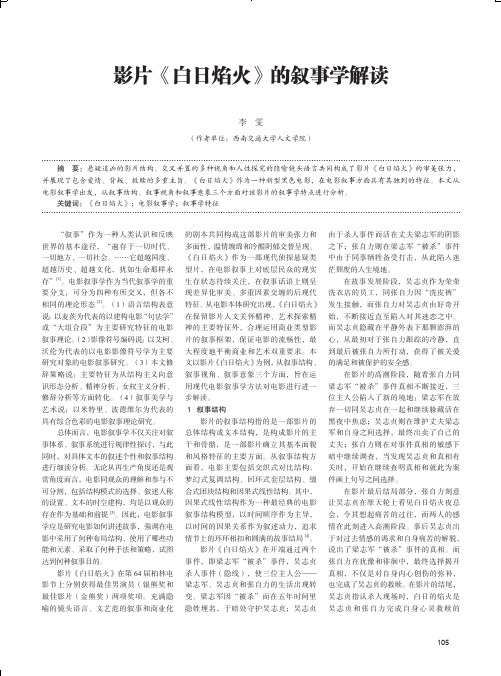
由于杀人事件而活在丈夫梁志军的阴影 之下;张自力则在梁志军“被杀”事件 中由于同事牺牲备受打击,从此陷入迷 茫颓废的人生境地。 在故事发展阶段,吴志贞作为荣荣 洗衣店的员工,同张自力因“洗皮裤” 发生接触,而张自力对吴志贞由好奇开 始,不断接近直至陷入对其迷恋之中。 而吴志贞隐藏在平静外表下那颗澎湃的 心,从最初对于张自力跟踪的冷静,直 到最后被张自力所打动,获得了被关爱 的满足和被保护的安全感。 在影片的高潮阶段,随着张自力同 梁志军“被杀”事件真相不断接近,三 位主人公陷入了新的境地:梁志军在放 弃一切同吴志贞在一起和继续躲藏活在 黑夜中焦虑;吴志贞则在维护丈夫梁志 军和自身之间选择,最终出卖了自己的 丈夫;张自力则在对事件真相的敏感下 暗中继续调查,当发现吴志贞和真相有 关时,开始在继续查明真相和就此为案 件画上句号之间选择。 在影片最后结局部分,张自力刻意 让吴志贞在摩天轮上看见白日焰火夜总 会,令其想起痛苦的过往,而两人的感 情在此刻进入高潮阶段。事后吴志贞出 于对过去情感的渴求和自身痛苦的解脱, 说出了梁志军“被杀”事件的真相。而 张自力在犹豫和徘徊中,最终选择揭开 真相,不仅是对自身内心创伤的弥补, 也完成了吴志贞的救赎。在影片的结尾, 吴志贞指认杀人现场时,白日的焰火是 吴志贞和张自力完成自身心灵救赎的
摘 要:悬疑追凶的影片结构、交叉并置的多种视角和人性探究的隐喻镜头语言共同构成了影片《白日焰火》的审美张力, 并展现了包含爱情、背叛、救赎的多重主旨。《白日焰火》作为一种新型黑色电影,在电影叙事方面具有其独到的特征。本文从 电影叙事学出发,《白日焰火》;电影叙事学;叙事学特征
的剧本共同构成这部影片的审美张力和 多面性,温情缠绵和冷酷阴郁交替呈现。 《白日焰火》作为一部现代侦探悬疑类 型片,在电影叙事上对底层民众的现实 生存状态持续关注,在叙事话语上则呈 现差异化审美、多重因素交缠的后现代 特征。 从电影本体研究出现, 《白日焰火》 在保留影片人文关怀精神、艺术探索精 神的主要特征外,合理运用商业类型影 片的叙事框架,保证电影的流畅性,最 大程度地平衡商业和艺术双重要求。本 文以影片 《白日焰火》 为例, 从叙事结构、 叙事视角、叙事意象三个方面,旨在运 用现代电影叙事学方法对电影进行进一 步解读。 1 叙事结构 影片的叙事结构指的是一部影片的 总体结构或文本结构,是构成影片的主 干和骨骼,是一部影片确立其基本面貌 和风格特征的主要方面。从叙事结构方 面看,电影主要包括交织式对比结构、 梦幻式复调结构、回环式套层结构、缀 合式团块结构和因果式线性结构。其中, 因果式线性结构作为一种最经典的电影 叙事结构模型,以时间顺序作为主导, 以时间的因果关系作为叙述动力,追求 情节上的环环相扣和圆满的故事结局 。 影片《白日焰火》在开端通过两个 事件,即梁志军“被杀”事件,吴志贞 杀人事件(隐线),使三位主人公—— 梁志军、吴志贞和张自力的生活出现转 变。梁志军因“被杀”而在五年时间里 隐姓埋名,于暗处守护吴志贞;吴志贞
《2024年从目的论的角度谈英文电影片名的翻译》范文
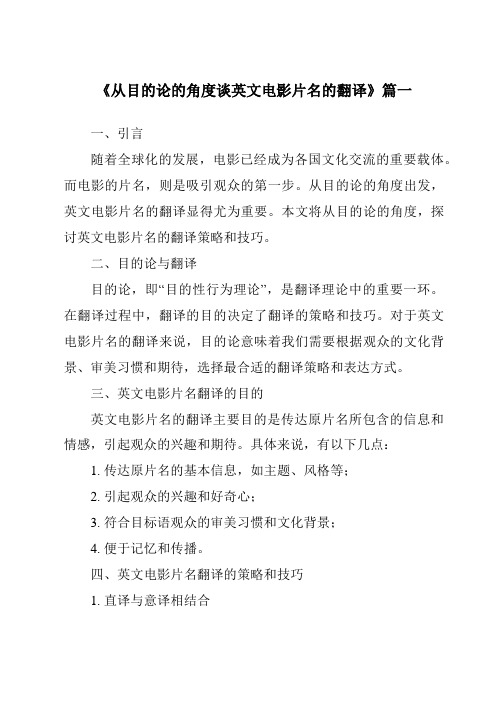
《从目的论的角度谈英文电影片名的翻译》篇一一、引言随着全球化的发展,电影已经成为各国文化交流的重要载体。
而电影的片名,则是吸引观众的第一步。
从目的论的角度出发,英文电影片名的翻译显得尤为重要。
本文将从目的论的角度,探讨英文电影片名的翻译策略和技巧。
二、目的论与翻译目的论,即“目的性行为理论”,是翻译理论中的重要一环。
在翻译过程中,翻译的目的决定了翻译的策略和技巧。
对于英文电影片名的翻译来说,目的论意味着我们需要根据观众的文化背景、审美习惯和期待,选择最合适的翻译策略和表达方式。
三、英文电影片名翻译的目的英文电影片名的翻译主要目的是传达原片名所包含的信息和情感,引起观众的兴趣和期待。
具体来说,有以下几点:1. 传达原片名的基本信息,如主题、风格等;2. 引起观众的兴趣和好奇心;3. 符合目标语观众的审美习惯和文化背景;4. 便于记忆和传播。
四、英文电影片名翻译的策略和技巧1. 直译与意译相结合在翻译过程中,既要尽量保留原片名的信息,又要符合目标语的语言习惯和文化背景。
直译可以传达原片名的基本信息和主题,而意译则可以根据目标语的特点进行适当调整,使其更符合观众的审美习惯。
例如,英文电影名“Titanic”可以直译为“泰坦尼克号”,这样的翻译保留了原片名的信息,也方便了观众记忆。
但如果根据目标语的特点进行适当调整,可以翻译为“无尽的追忆”,更能表达原片名所传达的浪漫情感。
2. 考虑文化差异在翻译过程中,要充分考虑文化差异。
有些英文电影的片名在中文中可能存在歧义或难以理解的情况,这时需要结合电影的内容进行适当的调整。
例如,“The Shawshank Redemption”中的“Redemption”在中文中可以译为“救赎”,但也要考虑到中文观众对“救赎”的理解可能有所不同,因此可以结合电影内容译为“绿里奇迹”。
3. 创新与独特性在满足基本要求的前提下,翻译者还可以通过创新和独特性的表达方式来吸引观众的注意力。
从目的论角度浅谈电影英语字幕翻译
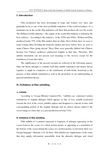
I. IntroductionFilm production has been developing in leaps and bounds ever since and gradually boom as one of the most profitable industries of the world nowadays. As a dominant role in the world, film industries sell their film products all over the world. The Hollywood film industry----the engine of the world film industry is definitely the best evidence.According to the statistics,in the 1930s and 1940s,Hollywood films produced nearly 75% of the film market share in china. Never before have we seen so many foreign films flooding the domestic market and never before have we seen so many Chinese films going abroad. These films were generally dubbed into Chinese because few Chinese audiences understood English at that time. Therefore, film subtitle translation can not present real meanings to the viewers except for the translation of some inter-titles.The significances of the present research are reflected in the following aspects. Since the thesis attempts to combine both film subtitle translation and skopos theory together, it might be conductive to the enrichment of both fields, beneficial to the practice of film subtitle translation as well as the promotion of our understanding of general translation theory.II. Definition of film subtitlingA. SubtitleAccording to George-Michael Luyken(1991), “subtitles are condensed written translations of original dialogue which appears as line of text, usually positioned towards the foot of the screen, subtitles appear and disappear to coincide in time with corresponding portion of the original dialogue and are almost always added to the screen image at a later date as a post-production activity”(335).B. Definition of film subtitlingFilm subtitle is “a printed statement or fragment of dialogue appearing on the screen between the scenes of a silent motion picture or appearing as a translation at the bottom of the screen during the scenes of a motion picture or television show in a foreign language” (Merriam 1175). In short,film subtitles are supplements,in the sense that they supply information unavailable from the phonetic dialogue and visualpicture.Film subtitles are different from “displays” or “captions”. “Displays” are “fragments of text recorded by the camera-letters, newspapers, headlines, banners etc” (Gottlieb l01-121). “Captions” (or “top titles”) are pieces of “textual information usually inserted by the program maker to identify names,places or dates relevant to the story line”(Luyken). This distinction is maintained here and “subtitles”do not include displays or captions, unless otherwise stated.Film subtitle can be both “intralingual”(and “vertical”), when the target language is the same as the source language, and “intralingual” (or “diagonal”), when the target language is different from the source language (Gottlieb 249-258). “Film subtitle”in this thesis is used to refer to interlingual film subtitle, unless otherwise stated.Film subtitle can be “open”, when the target text constitutes a physical part of the translated film and is transmitted together with the film sound and image,or “closed”, when the target text is stored in a digital/teletext format which is transmitted in as well as accessed via a separately coded channel at the discretion of the viewers(Gottlieb 247). In this thesis, “film subtitle”, refers to open film subtitle, unless otherwise stated.III. A brief introduction to skopostheorieA. The process of skoposSkopos is the Greek word for “aim” or “purpose” and was induced into translation theory in the 1970s by Hans J. Vermeer as a technical term for the purpose of a translation and of the action of translating skopos focuses on the purpose of the translation, which determines the translation methods and strategies that are to be employed in order to produce a functionally adequate result, the target text (TT), called the translatum by Vermeer (20-23). Therefore,in skopos theory,knowing why an source text (ST) is to be translated and what the function of the TT will be are crucial for the translator.In the 1970s there appeared a school in translation studies in Germany functionalism. Katharina Reiss firstly pointed out in his work Translation Criticism (2004). The representatives are Katharina Reiss, Hans J. Vermeer and Christiane Nord. They hold that translation is a kind of action with a purpose. This theory is first presented by Reiss and Vermeer in their book Grundlegung einer allgemeinen Translationstheorie (1984) (General Foundations of Translation Theory).Since 1978, German translation theorist H. J. Venneer, who breaks through thetraditional equivalence-based the theory that centers on source text,creates the skopostheories with the translation purpose or function of a translation as a general principle on the basis of theory of action(23-24). It is generally agreed now that translation is a type of human action. According to Vermeer, human action is intentional and purposeful behavior that takes place in a given situation, which modifies the situation at the same time (205-210). Skopos argues that the shape of target text should above all be determined by the function or “Skopos”that it is intended to fulfill in the target context.Vermeer believes that the purpose of a target text determines the translation strategies. In his opinion, the purpose of a target text, which is so important, is great extent decided by target readers, cultural background. In Hans J Vemeer’s Skopos and Commission in Translational Action(1989),Vemmer puts the Skopostheorie in this way:“Any form of translation action, including therefore translation itself, maybe conceived as an action, as the name implies. Any action has an aim, a purpose. The word Skopos, then, is a technical term for the aim or purpose of a translation.” In her book Translating as a Purposeful Activity: Functionalist Approaches Explained (2001), Christiane Nord defines the skopostheorie that “Skopos is a Greek word for purpose”(13-14). According to skopostheorie (the theory that applies the notion of Skopos to translation), the prime principle determining any translation process is the purpose (skopos) of the overall translational action. This fits in with intentionality being part of the very definition of any action.B. Three rules of the SkopostheorieSkopos theory involves three rules, i. e. skopos rule, coherence rule and fidelity rule, which will be discussed as follows.1. Skopos ruleVermeer postulates that as a general rule it must be the intended purpose of the target text that determines translation methods and strategies. From this postulate, he derives the skopos rule: Human action(and its subcategory:translation) is determined by its purpose(Skopos), and therefore it is a function of its purpose(Baker 236).Vermeer explains the Skopos rule in the following way,“Each text is produced for a given purpose and should serve this purpose. The skopos rule thus reads as follows: translate/interpret/speak/write in a way that enables your text/translation to function in the situation in which it is used and withthe people who want to use it and precisely in the way they want it to function” (29).It is also pointed out that most translational actions allow a variety of skopos, which may be related to each other in a hierarchical order, and the translator should be able to justify their choice of a particular skopos in a given translational situation in translation, i.e., the skopos must be decided separately in each specific case.Skopos rule helps the translator solve the eternal dilemmas of free vs. faithful translation, dynamic vs. formal equivalence, and so on. Nord points out that the skopos of a particular translation task may require a “free” or a “faithful” translation, or anything between these two extremes, depending on the purpose for which the translation is needed. (29).2. The coherence ruleTwo further general rules are the coherence rule and the fidelity rule. The coherence rule stipulates that the target text must be sufficiently coherent to allow the intended users to comprehend it, given their assumed background knowledge and situational circumstances.The coherence rule, or in Vermeer’s terms, the standard of “intra-textual coherence” means “the receiver should be able to understand it: it should make sense in the communicative situation and culture in which it is received”(Nord 32). The coherence rule specifies that “a t ranslation should be acceptable in a sense that it is coherent with the receivers’ situation” (Nord 32).That is to say, the translator’s task is to produce a text that is at least likely to be meaningful to target-culture receivers, namely, to be coherent with the receivers’situation and thus to be understood by the receivers. Only when the receivers understand it as being sufficiently coherent with their situation, can this communicative interaction be regarded as successful.3. The fidelity ruleHowever, just being coherent with the target situation is not enough. A translation is an offer of information about a preceding offer of information; therefore there is a relationship between the translation and the source text. Vermeer calls this relationship “inter-textual coherence or “fidelity”. This is postulated as a further principle, referred to as the “fidelity rule” (Nord 32)“Inter-textual coherence should exist between source and target text, while the form it takes depends both on the translator’s interpretation of the source text and on the translation skopos” (Nord 1-32). For example, one possible kind of inter-textualcoherence could be a maximally faithful imitation of the source text.We know that the source text is intended for the source culture receivers instead of translation,therefore when it is translated for the different target-culture recipients, maybe the function of the target text or the purpose of the translation is different from that of the source text. In this case,the “fidelity rule” should give way to the skopos rule. However, the translator should aim for any possible compatibility between the skopos and inter-textual coherence.The three basic rules of the skopostheorie are designed to govern the translator’s activities in the whole translation process. In most cases, due to the reason that the skopos of the translation is frequently likely to deviate from the intention of the corresponding source language text, a translation cannot satisfy the three rules at the same time.IV. Film subtitle translation of If You Are the One from the perspective of skopostheorieIn subtitle translation of If You Are the One, in particular, its skopos is determined by the intention of its director as the initiator and the expectation of the English speaking viewers as the receivers of the English subtitles; its shape is determined by its skopos and the subtitler. This part is to analyze how the factors mentioned above determine the skopos and shape of translated subtitles in If You Are the One, and how strategies are employed to fulfill its skopos.A. Brief review of the film If You Are the OneThe film for 2008, If You Are the One, stars Feng’s longtime collaborator, Ge You, as a man in his 40s, newly rich, looking to settle down and start a family. Having made an instant fortune through his sale of the Conflict Resolution Terminal 2008, middle-aged entrepreneur Qin Fen (Ge You) turns his attention to finding a wife. Using all online personals service, he auditions potential spouses, but few make a lasting impression. Qin Fen’s stalwart personality is partly to blame;he’s intent on finding a suitable match,and is willing to walk away from even an absolute goddess if there’s a hint of incompatibility. So it goes with comely flight attendant Smiley Liang (Shu Qi), who Qin Fen initially recognizes as a poor match. Regardless, the two commiserate over drinks, where the melancholy Smiley reveals that she’s dating amarried man (Alex Fong). The two parts intends never to meet again, with each returning to their own pursuit of love.But as fate and the screenwriters would have it, Qin Fen and Smiley meet again on all airline flight,with Smiley working, Qin Fen traveling, and Smiley’s boyfriend and wife also present. The coincidence draws Qin Fen and Smiley back together, propelling them on the road to friendship and perhaps more, with occasional stops at fine luxury entertainment locations, where they sip expensive drinks while verbally sparring over their views on love. Qin Fen aims for a home run with his potential mate, while Smiley seems willing to settle if she can’t have her idealized,unattainable love. In response, Qin Fen tries to convince her otherwise while attempting not to appear as he’s trying to. It’s the story of one man’s tough love, except with a picturesque tour of fabulous locations that only people with money can visit. Somewhere in there, Qin Fen’s loyalty and stalwart affection is supposed to comfort Smiley’s wounded heart or something like that.B. An analysis of subtitle translation of If You Are the One based on skoposIn subtitle translation of If You Are the One, in particular, its skopos is determined by the intention of its director Feng Xiaogang as the initiator and the expectation of the English-speaking viewers as the receivers of the English subtitles; its shape is determined by its skopos and the subtitler. This part is to analyze how the factors mentioned above determine the skopos and shape of translated subtitles in If You Are the One and how the strategies are employed to fulfill its skopos.1. Feng Xiaogang’s intentionFeng never denies his wish to defeat the Hollywood films at the box office by adapting Hollywood’s game rules (Rosen 336).Feng discloses that the Associate President of Columbia Pictures, Mr.Geris once said to him, “Your films have never been shown in overseas countries and thus you are not known to the viewers outside your country.Big Shot’s Funeral serves as an advertisement to publicize you and I hope it can provide the foundation for your second and third film in the overseas market” (Feng 187). From Mr. Geris’s wish, we can also find F eng’s ambition to gain the market share in foreign countries. And the film If You Are the One has proved to be well received in the North American market.Feng recalls in his book that on a seminar about the making of Big Shot’s Funeral,some people asked him whether the production strategy of the film should beconsidered as Hollywood’s cultural invasion into Chinese film industry. He replies that “it is a win-win deal and a two-edged sword” and that this kind of cooperation is cost-efficient because it “still makes Chinese films,but faces the global market” (Feng 187). As for Feng Xiaogang, the way to revive domestic market and march into international market is to cooperate with foreign film production companies and internationalize domestic film success.From above,we can see that the director’s intention is to bridge the gap between Chinese and foreign cultures and gain market share in foreign countries,which is the major part of translation brief.2.Skopos analysisTo define the skopos, we should verify the translation brief. Although it is said that a brief should be given by the clients, more often than not, it is not the case. Then a translator should have the ability to verify it by himself. The translation brief of the present case could be specified as follows:a. The intended text functions: the main function of the TT is referential. If You Are the One is more a commercial movie than art,the intended text function is first of all referential, to provide information about what is going on the screen. Then it may come the expressive function to relay the sender’s attitude and feelings. The translator must weigh against different functions and decide on the main one. In the present case,it is the referential function that wins the upper hand. Translator has to make a choice according to the skopos of the translation of film subtitle. Feng’s film subtitle translation aims to win the target market so that translator has to produce clear and concise subtitled film dialogues bridging the cultural gaps and make the narrative easily accessible for the audience.Thus, the target audience will find it easier to accept and understand the translated subtitles. Here are some examples.(1)秦奋:不算老实但天生胆小I'm no angel杀人不犯法我也下不去手Just too cowardly to do wrongThe west and east have different religious beliefs. In Christianity, Angel is a good spirit who is kind, lovely and innocent. Here, Qin Fen describes himself as a man who is not well-behaved.So he is not like an angel.(2)别猫哭耗子了Spare me the alligator tearsIn China, there is a proverb“猫哭耗子假慈悲”. This means the cat pretends to be sympathetic to the death of the mouse because she can have it as a meal. In western culture, people think that while having meals, usually an animal, an alligator will shed tears. So alligator tears implies disguised sympathy.(3)有的人是情人眼里才是西施Beauty is in the eyes of the beholder不过分的说, 仇人眼里你都是西施But no exaggeration, even to a foe,you’d be beautifulThe above underlined words or proverbs are all culture-loaded. Domestication is adopted to make the western audience fully understand the film.b. The addressees:It is self-evident that the TT addressees in subtitle translation are the foreign audience, probably adults, who share a different culture background and who are lay of Chinese. To be specific, they are common people who watch it for entertainment and film festival juries who view it with a discerning eye, eg.秦奋:那咱俩要是结婚了So,if we get married非得倒插门我去你们那儿吗I have to go to live with your family?In China, in most cases,after marriage, the wife lives with the husband’s family. “倒插门”means the husband lives with wife’s family. In this sentence, it is deleted since it expresses the same meaning as “我去你们那儿”.c. The time and place of text reception: The time and space of reception is less controversial,which vary in different cases. In this case, the time is up to now from 2008 when it was released to the public and the place is at the very beginning cinema and later on amounts to a wide range of places thanks to the development of technologies such as DVD.So far, the skopos of the translation can be defined as to supplement the film by providing the optimal information for the audience in written form within a limited time and space.V. Film subtitle translation of Curse of the Golden Flower from the perspective of skopostheorieIn this part, the subtitle translation of Curse of the Golden Flower is analyzedwith the background of the skopos theory.A. Background of Curse of the Golden FlowerCurse of the Golden Flower is derived from the story Thunderstorm, one of the best-known masterpieces by the most famous Chinese playwright Cao Yu. But the adaptation doesn’t stay too faithful to the original. The film is a historical drama directed by Zhang Yimou who also co-wrote the screenplay in Chinese. The screen version is established in the 10th century during the short-1ived Late Tang Dynasty, about a thousand years ago.For today’s viewers,it is a story about court intrigues and deceptions. Moreover there are several pivotal factors within the plot, among which, traditional Chinese medicine is the foremost one since the Emperor in the film is gradually poisoning his wife, the Empress, by adding a deadly fungus to her medicine. Zhang Yimou the director gives his explanation of the arrangement that “as for the Emperor’s personality, well, he’d love to stay in the royal pharmacy all the time. He’s a drug freak. That’s how his character is developed and expanded upon. He’s just so into the drug”.B. An analysis of subtitle translation of Curse of the Golden Flower based onskoposThe title of the movie,which is literally translated as “The Whole City is Clothed in Golden Armor”, is the last line taken from a Tang Dynasty poem---Do not Endow with Chrysanthemum Behind written by Huang Chao who rose in rebellion in 875 and died 9 years later.After changing the title several times, the screenwriters as well as the director finally settle on the poem for the reason that it indicates the rebellion taken by the Prince against the Emperor in the movie. The Chinese audience may easily understand the cultural connotation while the English-speaking audience who are not familiar with the background of the poem, due to the great disparity in terms of cultural background, may not comprehend the implicit aspects of the title without the explanatory message or footnote. Consequently, this kind of culturally loaded expressions will put a lot of processing efforts on the target audience. In addition, with the constraints of time and space, if they focus on the reading of the subtitle, they will lose some of the visual and audio information.To solve this problem, the subtitler discards the Chinese title and adapts a new one with the image of the golden flower taken as a symbol to reveal the palace intrigue and the machination of power play to the target audience. The golden flower is designed to function as the symbol of rebellion, which is the same as the title. Hence its images appearing in the film once and again will, in another form, retrieve the loss of the culturally loaded information caused by the substitution since film is a multidimensional art involving visual images, sound, colors and so on. Let’s see some examples:(1)辰时的药煎好了Your Majesty’s medicine for the hour is ready(2)执令官统领后宫羽林军The Imperial Guards protect our private palacesIt is no easy job to translate cultural elements in subtitle translating. The underlined parts of the source text are omitted in the target text since these cultural elements do not deliver adequate information and there is no time to explain all details. Their function can be retrieved by the image and the subtitler is careful enough not to omit information that could at a later stage be essential for the understanding of the story.According to adequacy and equivalence theory, the translator can not offer the same amount and kind of information as the source-text producer. What the translator does is to offer another kind of information in another form (Reiss & Vermeer 123). Located in a broader ecological culture, the subtitling succeeds in producing a communicative interaction in the target text. We may find another example in this film:(3)当年你只是一个小小的都尉At that time,you were only a lowly captain.“都尉”here refers to the low-ranking officer in Tang Dynasty. If a simple transliteration as “Duwei”is adopted, it is completely meaningless to the English-speaking audience and fails to achieve intra-textual coherence. Whether to translate the complete meaning of “Duwei”, on the other hand, makes no difference to the comprehension of the plot for the source text producer just means that the Emperor mounts the throne from the bottom. Therefore the subtitler, by chunking it up, translates it into “a lowly captain” to establish inter-textual coherence as well as intra-textual coherence in the target text.(4)儿臣为了母后从此不再服药You will never drink the poison again.In the film, what the Empress drinks is a kind of Chinese medicine containing the ingredient that will cause a person to lose his or her entire mental faculty. According to traditional Chinese medicine, any medicine has 30% poison ingredients. Therefore some ingredients are useful as well as poisonous. Their curative value is restricted to certain diseases and certain dosage based on the theory of using poison to cure poison. These ingredients belong to the category of medicine despite of their toxicity. By chunking down the medicine into poison, the subtitler defines the meaning in the narrowest sense and makes the implicit information explicit to accomplish intra-textual coherence in the target text.VI. ConclusionA. ContributionSkopostheorie provides translators with a whole new perspective into translation action. This paper conducts a systematic analysis of crucial factors that influence the strategies of subtitle translation, in which skopostheorie is adopted to guide the descriptive and explanatory analysis.On the basis of the above analysis, this paper gets some enlightenment of skopostheorie on subtitle translation. The enlightenment of “intra-textual coherence”on subtitle translating is that the target receiver should be able to understand the translated version of subtitle. And the translated version should make sense in the communicative situation and culture in which it is received. The subtitler should always keep the target viewers in mind. After exploring the main components of skopostheorie and analyzing the specific constraints in film subtitle translation, the author tries to find out some enlightenment of skopostheorie on subtitle translation. In order to find out th e enlightenment, this paper analyzes Feng Xiaogang’s film in light of skopostheorie. The film If You Are the One proves to be successful in its target market. Therefore, this paper tries to find out influencing factors that affect the subtitler’s choice of strategies.The author gives focus to the skopos of subtitle translation, the more influencing role of the film director in subtitle translation and the importance of target audience. With reference to skopostheorie,subtitle translating is a purposeful activity and thepurpose of the whole translational action is the prime principle that determines the translation process. The basic purpose or skopos of subtitle translation is to aid the viewers with a translated film dialogue, to provide them with the most relevant information in the most effective way within its specific constraints,to help them in understanding what’s happening on the screen with ease.B. LimitationsOwing to the limitations of time and space,the source data collected for the thesis is limited. Meanwhile because of the knowledge limitations this paper can not deeply analyzes the translation of Chinese film subtitles into English ones from the perspective of skopostheorie. It is the author’s sincere wish that if possible, in the future, further research can be done on comparative study on Chinese-English translation and English-Chinese translalion of film subtitles.Work CitedBaker, Mona. Routledge Encyclopeata of Translation Studies. Shanghai:Shanghai Foreign Language Education Press(2004):Baker,Christiane, Nord. Translating as a Purposeful Activity: Functional Approaches Explained.Shanghai: Shanghai Foreign Language Education Press, 2001.Feng, X. G[冯小刚]我把青春献给你武汉:长江文艺出版社2003: 187Gottlieb, H. Teaching Translation and Interpreting. Amsterdam: John Benjamins Publishing Company, 1998Gottlieb, H. Media Translation. Amsterdam/Philadelphia: John Benjamins Publishing Company, 2001Gottlieb, H. Subtitfing: Diagonal translation In C. Dollerup et al. (eds), Perspectives Studies in Translatology. Copenhagen: University of Cpenhagen, 1994 l01-121.Gottlieb, H. Anglicisms and TV Subtitles in an Anglified World: [A] Gambier Yves, 249-258 Gottlieb, H.Subtitling-a new university discipline in Teaching Translating and Interpreting. (eds) Dollerup, Cay&A. Loddegaard.70-161. Amsterdam: John Benjamin. 1998: 247 Katharina, Reiss. Translation Criticism: The Potentials&Limitations. Shanghai: Shanghai Foreign Language Education Press, 2004.Katharina, Reiss and Hans J. Vermeer. Grundlegung einer allgemeinen Translationstheorie.Tubingen:Niemeyer, 1984Luyken.George,Michael. Overcoming Language Barriers in Television. [M] Manchester:European Institute for the Media 1991.Luyken,George-Michael. Overcoming Language Barriers in Television. [M] Manchester: European Institute for the Media 1991.Merriam-Webster. Merriam Webster's Collegiate Dictionary. 1997:1175Rosen,S.(2002).狼来了:好莱坞与中国电影市场,. 全球化与中国影视的命运336-360. (S.Y Sun, Trans.). Shanghai: Shanghai Foreign Language Education Press. 1994-2000 Vermeer, Hans J. Skopos and Commission in Translational Action in Chesterman(ed). 1989, 20-233.。
目的论视角下的字幕翻译:以《白日梦想家》为例
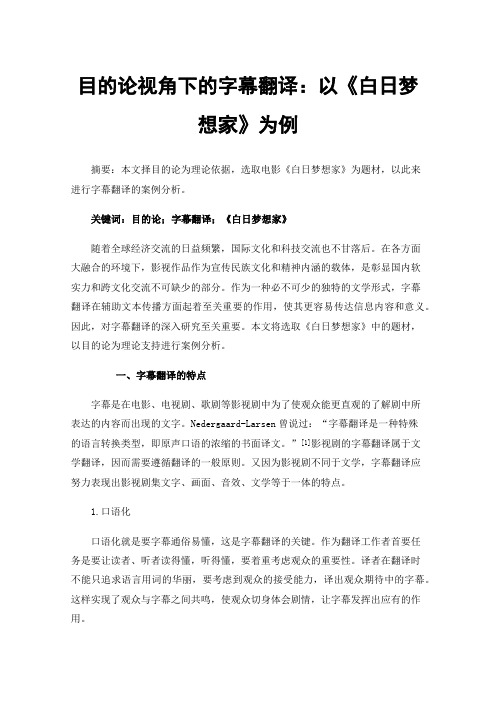
目的论视角下的字幕翻译:以《白日梦想家》为例摘要:本文择目的论为理论依据,选取电影《白日梦想家》为题材,以此来进行字幕翻译的案例分析。
关键词:目的论;字幕翻译;《白日梦想家》随着全球经济交流的日益频繁,国际文化和科技交流也不甘落后。
在各方面大融合的环境下,影视作品作为宣传民族文化和精神内涵的载体,是彰显国内软实力和跨文化交流不可缺少的部分。
作为一种必不可少的独特的文学形式,字幕翻译在辅助文本传播方面起着至关重要的作用,使其更容易传达信息内容和意义。
因此,对字幕翻译的深入研究至关重要。
本文将选取《白日梦想家》中的题材,以目的论为理论支持进行案例分析。
一、字幕翻译的特点字幕是在电影、电视剧、歌剧等影视剧中为了使观众能更直观的了解剧中所表达的内容而出现的文字。
Nedergaard-Larsen曾说过:“字幕翻译是一种特殊的语言转换类型,即原声口语的浓缩的书面译文。
”[1]影视剧的字幕翻译属于文学翻译,因而需要遵循翻译的一般原则。
又因为影视剧不同于文学,字幕翻译应努力表现出影视剧集文字、画面、音效、文学等于一体的特点。
1.口语化口语化就是要字幕通俗易懂,这是字幕翻译的关键。
作为翻译工作者首要任务是要让读者、听者读得懂,听得懂,要着重考虑观众的重要性。
译者在翻译时不能只追求语言用词的华丽,要考虑到观众的接受能力,译出观众期待中的字幕。
这样实现了观众与字幕之间共鸣,使观众切身体会剧情,让字幕发挥出应有的作用。
2.个性化字幕的语言主要是来自于人物之间的对话。
语言往往可以表达出受人物性格、地位、思想、经历和其他许多因素影响的强烈个性。
因此,个性化的翻译意味着准确感知人物的个性,沉浸在人物的特点和内心世界中,使观众所听到的译文言为人物的心声。
3.文化性电影是一个国家文化的产物,它承载着这个国家的民族文化,那么字幕语言就是传播载体。
虽然它只存在于特定的影视作品中,但是它是向外传播当地文化信息的主要途径。
在翻译过程中,译者必须处理包含文化信息的不同字幕语言,以便观众能够最好地感知母语字幕背后的文化信息,同时保留母语的文化和习俗。
从目的论角度浅谈纪录片字幕翻译【从目的论角度谈字幕翻译】

从目的论角度浅谈纪录片字幕翻译【从目的论角度谈字幕翻译】一、电影字幕翻译概述随着我国对外开放的深入,国家间经济文化的交流频繁,电影作为一种直观有效、影响面很广的跨文化交流途径也受到了越来越多的关注。
电影翻译主要有两种形式:配音和字幕翻译。
配音是对源电影对白的语言符号的听觉替代过程;字幕翻译作为源电影对白的书面翻译形式,成为对电影画面的一种视觉补足。
上个世纪八十年代曾经是配音的黄金期,但是配音使得观众无法从听觉的角度领略“原汁原味”的源电影语言。
因此随着社会的发展带字幕的原声电影越来越受到观众的欢迎。
一方面随着外语教育水平的不断提高,越来越多的人不需要中文配音,仅借助字幕就能理解影片内容,欣赏异语文化;另一方面在信息时代,配音电影的产量有限,而带字幕的电影能使人们更快更多的接受新鲜事物。
如今电影的观众数量远远超过文学翻译作品读者的数量,因此社会影响也绝不会在文学翻译作品之下。
而翻译界对电影翻译特别是字幕翻译的重视却远不如文学翻译,字幕翻译的质量也有待提高。
字幕有两种:语内字幕(intralingual subtitles)和语际字幕(interlingual subtitles)。
而通常所说的字幕翻译指的是语际字幕的翻译。
语际字幕指的是在保留影视原声的情况下,将源语译为目的语叠印在屏幕下方的文字。
字幕翻译属于文学翻译,具有文学翻译的一般特点,此外还具有其自身特点:第一,瞬时性。
电影字幕是闪现在屏幕上的文字,信息呈递进式推进,不像书本上的文字可以前后参照,也不容许加注说明。
第二,通俗性。
一方面电影画面一闪而过,观众没有时间思索字幕的含义,另外电影观众的面非常广,因此要求字幕翻译通俗易懂,雅俗共赏。
第三,语篇从口语转换为书面语。
第四,互补性。
字幕的出现基本未改变原片的图像声音信息,观众接收到的字幕信息和原声信息会发生互相作用,字幕所不能表达或者表达不充分的观众可以从原声那里得到补偿。
二、翻译的目的论作为对传统对等的反叛以及对翻译理论的重要补充,以凯瑟琳娜・赖斯(Katharina Reiss)、汉斯・威密尔(Hans Vermeer),贾斯塔・赫兹・曼塔利(Justa Holz Manttari)为代表人物形成了德国功能派翻译理论,威密尔提出的“目的论”是其核心。
《2024年从目的论的角度讨论英语电影片名翻译》范文
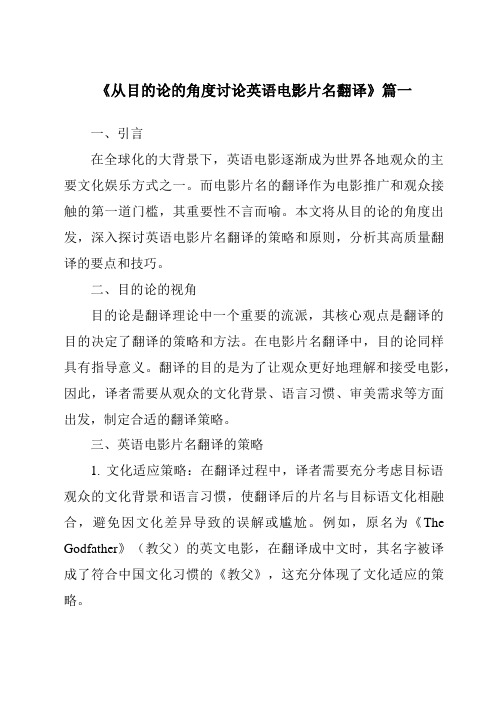
《从目的论的角度讨论英语电影片名翻译》篇一一、引言在全球化的大背景下,英语电影逐渐成为世界各地观众的主要文化娱乐方式之一。
而电影片名的翻译作为电影推广和观众接触的第一道门槛,其重要性不言而喻。
本文将从目的论的角度出发,深入探讨英语电影片名翻译的策略和原则,分析其高质量翻译的要点和技巧。
二、目的论的视角目的论是翻译理论中一个重要的流派,其核心观点是翻译的目的决定了翻译的策略和方法。
在电影片名翻译中,目的论同样具有指导意义。
翻译的目的是为了让观众更好地理解和接受电影,因此,译者需要从观众的文化背景、语言习惯、审美需求等方面出发,制定合适的翻译策略。
三、英语电影片名翻译的策略1. 文化适应策略:在翻译过程中,译者需要充分考虑目标语观众的文化背景和语言习惯,使翻译后的片名与目标语文化相融合,避免因文化差异导致的误解或尴尬。
例如,原名为《The Godfather》(教父)的英文电影,在翻译成中文时,其名字被译成了符合中国文化习惯的《教父》,这充分体现了文化适应的策略。
2. 信息简洁策略:片名往往需要在短短几个字内传达出电影的主题和情感色彩。
因此,在翻译过程中,译者需要尽量使翻译后的片名简洁明了,让观众一目了然。
例如,《Titanic》(泰坦尼克号)这一原题直接明了地传达了电影的主题和背景。
3. 情感传递策略:电影片名往往蕴含着丰富的情感色彩,因此,在翻译过程中,译者需要充分传达出原名的情感色彩,让观众能够感受到电影所要传达的情感。
例如,《The Notebook》(恋恋笔记本)这一翻译成功地将原名的情感色彩传达给了观众。
四、高质量英语电影片名翻译的要点和技巧1. 精准理解原意:在翻译过程中,译者需要准确理解原名的含义和情感色彩,确保翻译后的片名与原意相符。
2. 注重语言美感:片名作为电影的代表,其语言应具有一定的美感。
因此,在翻译过程中,译者应注重语言的运用和表达方式,使翻译后的片名具有艺术性和审美价值。
《2024年从目的论的角度谈英文电影片名的翻译》范文
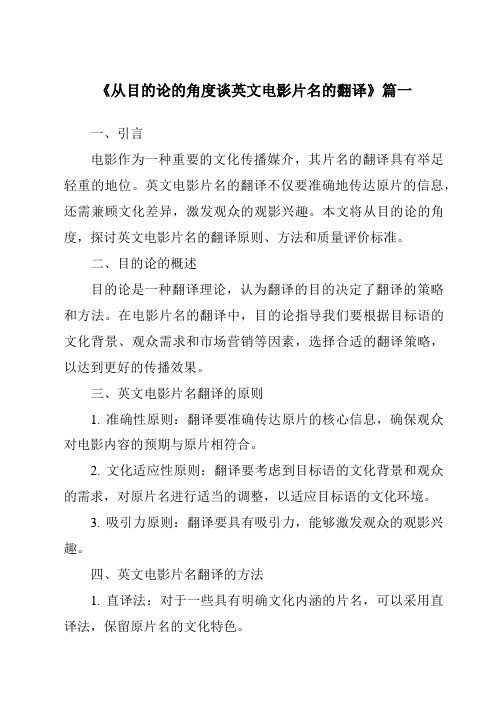
《从目的论的角度谈英文电影片名的翻译》篇一一、引言电影作为一种重要的文化传播媒介,其片名的翻译具有举足轻重的地位。
英文电影片名的翻译不仅要准确地传达原片的信息,还需兼顾文化差异,激发观众的观影兴趣。
本文将从目的论的角度,探讨英文电影片名的翻译原则、方法和质量评价标准。
二、目的论的概述目的论是一种翻译理论,认为翻译的目的决定了翻译的策略和方法。
在电影片名的翻译中,目的论指导我们要根据目标语的文化背景、观众需求和市场营销等因素,选择合适的翻译策略,以达到更好的传播效果。
三、英文电影片名翻译的原则1. 准确性原则:翻译要准确传达原片的核心信息,确保观众对电影内容的预期与原片相符合。
2. 文化适应性原则:翻译要考虑到目标语的文化背景和观众的需求,对原片名进行适当的调整,以适应目标语的文化环境。
3. 吸引力原则:翻译要具有吸引力,能够激发观众的观影兴趣。
四、英文电影片名翻译的方法1. 直译法:对于一些具有明确文化内涵的片名,可以采用直译法,保留原片名的文化特色。
2. 意译法:对于一些抽象或寓意性的片名,可以采用意译法,通过解释原片名的含义来传达信息。
3. 创意翻译法:根据目标语的文化特点和观众需求,进行创意性的翻译,使片名更具吸引力。
五、英文电影片名翻译的实践案例以《Titanic》为例,其片名直译为《铁达尼号》,但这样的翻译未能完全传达原片的情感色彩和文化内涵。
因此,采用了意译法,将片名翻译为《泰坦尼克号》,更好地体现了原片的情感色彩和文化内涵。
再如《Forrest Gump》,原意更接近于“愚蠢的人”的意思,但在中文文化中,我们采用直译与创意相结合的方法,将其翻译为《阿甘正传》,使其更具文化魅力。
六、质量评价标准1. 准确性:翻译是否准确传达了原片的核心信息。
2. 文化适应性:翻译是否考虑了目标语的文化背景和观众需求。
3. 吸引力:翻译是否具有吸引力,能否激发观众的观影兴趣。
4. 市场效果:翻译是否在市场上取得了良好的效果。
《2024年从目的论的角度谈英文电影片名的翻译》范文
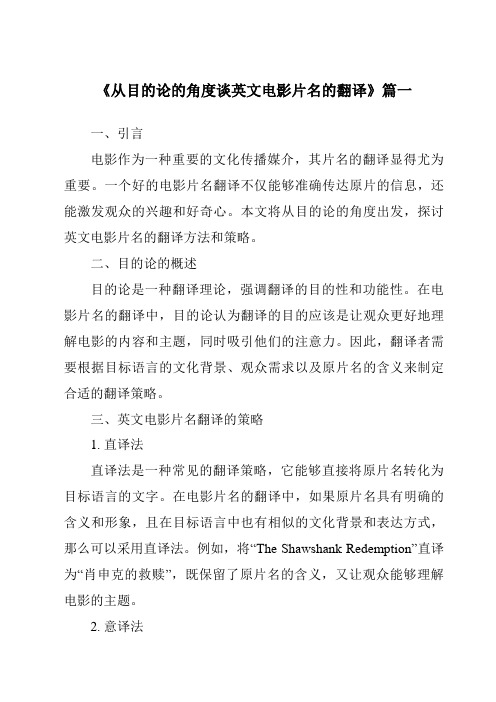
《从目的论的角度谈英文电影片名的翻译》篇一一、引言电影作为一种重要的文化传播媒介,其片名的翻译显得尤为重要。
一个好的电影片名翻译不仅能够准确传达原片的信息,还能激发观众的兴趣和好奇心。
本文将从目的论的角度出发,探讨英文电影片名的翻译方法和策略。
二、目的论的概述目的论是一种翻译理论,强调翻译的目的性和功能性。
在电影片名的翻译中,目的论认为翻译的目的应该是让观众更好地理解电影的内容和主题,同时吸引他们的注意力。
因此,翻译者需要根据目标语言的文化背景、观众需求以及原片名的含义来制定合适的翻译策略。
三、英文电影片名翻译的策略1. 直译法直译法是一种常见的翻译策略,它能够直接将原片名转化为目标语言的文字。
在电影片名的翻译中,如果原片名具有明确的含义和形象,且在目标语言中也有相似的文化背景和表达方式,那么可以采用直译法。
例如,将“The Shawshank Redemption”直译为“肖申克的救赎”,既保留了原片名的含义,又让观众能够理解电影的主题。
2. 意译法意译法是一种根据原片名的含义和内涵来制定新的翻译的策略。
在有些情况下,原片名可能包含一些特定的文化元素或隐喻,这些元素在目标语言中可能无法直接表达。
此时,翻译者需要通过对原片名的理解和分析,用目标语言来表达出相同的含义和情感。
例如,“The Wolf of Wall Street”意译为“华尔街之狼”,既传达了原片名的主题,又符合中文的表达习惯。
3. 音译法音译法是一种根据原片名的发音来制定翻译的策略。
在有些情况下,原片名具有一定的品牌价值或文化特色,翻译者可以采用音译法来保留原片名的发音和形式。
例如,“Avatar”音译为“阿凡达”,既保留了原片的品牌价值,又让观众能够感受到其神秘和奇幻的色彩。
四、英文电影片名翻译的注意事项1. 文化差异的考虑在电影片名的翻译中,文化差异是一个重要的考虑因素。
不同的文化背景和语言习惯可能导致对同一电影片名的理解和接受程度不同。
目的论视角下的电影字幕翻译-2019年精选文档

目的论视角下的电影字幕翻译1、目的论概述翻译目的论(Skopostheorie) 于20 世纪70 年代在德国兴起,是德国功能学派翻译理论中重要的理论。
在赖斯的“等值” 理论基础上,针对其缺陷,汉斯?弗米尔提出了一个重社会文化及交际功能的新观点,即目的论,其核心是翻译是一项有目的的行为。
他认为,一切活动皆有目的,翻译也是由特定目的支配的,它不仅仅是一个转码的过程。
因此,译者在翻译活动开始前需清楚翻译此文本的最终目的是什么,立足于译入语读者和翻译行为委托者,从而确定采用何种翻译策略和技巧,达到目标文本的预期功能。
文本的功能是由接受者的期望,交际环境和条件共同决定的。
2、电影字幕翻译的特点电影字幕有语内字幕和语际字幕之分。
语内字幕是将影片话语转化为同语言文本; 语际字幕是将影片中源语转化为目的语,且叠印在屏幕下方的文字,它以保留影视原声为前提。
文本指的是语际字幕翻译。
字幕翻译是多媒体翻译的一种,因此它不仅是语言符号的转换,还涉及图像和声音等要素。
字幕翻译作为一种特殊的文本形式,具有其自身的特点。
2.1瞬间性。
不同于其他文学作品,读者可以慢慢欣赏,细细品味,电影字幕必须同影片画面对白保持同步,因此字幕稍纵即逝,观众无法反复琢磨,也无法将电影停止或回到之前的情节。
所以字幕翻译语言必须精炼,不能使用复杂的结构或隐晦的措辞,让观众即能理解一闪即过的字幕,又能观看到影片画面。
2.2简洁性。
电影字幕在时间和空间上都有限制。
通常字幕在屏幕上停留的时间仅有两到三秒。
并且在字数上也有一定限制,一般为一到两行。
所以字幕翻译应避免运用冗长的字句或过度运用修饰技巧,不拖泥带水,尽量用少的字数和简单明了的语言表达与原文相同的信息量。
2.3通俗性。
电影作为一种大众媒体形式,面对的是普通大众,整个字幕翻译要考虑到影片的基调和作者的意图,注意观众的接受程度和市场反应。
译文应使用通俗化、大众化和与人们日常生活环境中息息相关的语言,让观众一看就懂,欣赏和体会到与源语影片相同的效果和感受。
《白日焰火》解说文案_白日焰火——绚烂烟火,生不逢时

《白日焰火》解说文案_白日焰火——绚烂烟火,生不逢时中国犯罪/剧情/悬疑电影《白日焰火》,于2014年上映,由刁亦男导演,刁亦男编剧,影片讲述了五年前,吴志贞的丈夫梁志军被认定死于一桩碎尸案,张自力击毙了持枪拒捕的凶手。
五年后,又发生了类似的连环案件,并且这些死者都曾与吴志贞相恋。
张自力在接近吴志贞时飞蛾扑火般爱上了她,也发现了五年前的真相……。
“看到了什么吗?”“白日焰火”从摩天轮上向漆黑一片的外面望去,“白日焰火”的招牌发出幽暗阴冷的光。
在那一刻,吴志贞看到的是白日焰火夜总会的招牌,也看到的是自己。
白日绽放的焰火。
也许,焰火本来是该属于夜空的。
只有漆黑的夜才能衬托焰火的美丽绚烂,而青天白日下,焰火显得如此落寞与多余。
吴志贞就是那个在白天绽放的焰火,白天,衬托不了她的美丽,却是比焰火本身更大的光明。
吴志贞的生活需要光明与希望,就像爱能带给她的,些微的光明。
张自力到底有没有真心爱过吴志贞,我不能确定。
但是可以确定是吴志贞爱上了这样一个执着的男人。
虽然她明知道这可能是一个危险的男人,但是孤独的内心哪能抵挡冬日里那不经意的温暖。
也许只是一个眼神,一句话,都足以融化吴志贞看似冰冻的内心。
而吴志贞爱梁志军么?显然,并不如梁志军爱她那般深。
所以她很坦然的编出了梁志军抢劫杀人的谎言,她希望梁志军死,这个纠缠着自己的“活死人”,只有梁志军死了,她才能真正从那段阴暗的岁月中逃离出来,她才能大胆的去爱她想爱的人。
而为什么最后吴志贞要选择坦白呢?她完全可以编造说她被人强暴时梁志军发现了,然后杀了对方。
反正,死无对证。
这一切,因为吴志贞对爱的绝望。
哪怕焰火曾经绚烂,可是它稍纵即逝,生活终究归于平静清冷。
张自力会为破了一桩悬案而洋洋得意,而吴志贞会因为背负着这个秘密而受尽煎熬,当她知道张自力身份的那一刻,她就明白两个人注定不可能有什么结果。
她不过是张自力手里的一张牌而已,张自力也没有真正爱过她。
张自力本身体现出更多的是一个性瘾者罢了(影片有三处可以印证:一是开篇对前妻强烈的占有欲,二是吴志贞在张自力拿去洗的皮裤里找到的避孕套,三是当工友拿他和另一个单身女人开玩笑时,他没有觉得不好意思,反而对女人上下其手),张自力对异性的强烈欲望让他在调查吴志贞时对这样一个漂亮有些冰冷的女人产生了不可遏制的情愫,而这种情愫理解成爱有点牵强,但是无论如何,在吴志贞眼里,这分明就是爱,在摩天轮之夜第二天早晨,吴志贞一反常态的涂上了口红,问张自力,今晚还见面么?在那个观众啥也没看到却心知肚明的夜晚,吴志贞彻底被这个壮汉征服了,无论是身体还是心灵,所以在得知真相后,绝望替代了爱,为爱存在的吴志贞此刻选择了放下,放下过往,放下背负多年的秘密,放下那些所谓的爱,平静不再挣扎。
《2024年从目的论角度浅谈英文电影片名翻译》范文

《从目的论角度浅谈英文电影片名翻译》篇一一、引言电影作为一种重要的文化传播媒介,其片名翻译对于观众的理解和接受具有至关重要的作用。
本文将从目的论的角度,探讨英文电影片名翻译的高质量标准和方法。
首先,我们将简要介绍目的论的基本概念及其在翻译领域的应用;其次,分析英文电影片名翻译的特殊性和挑战;最后,提出一些高质量的翻译策略和方法。
二、目的论的基本概念及其在翻译领域的应用目的论是一种翻译理论,它认为翻译的目的决定了翻译的策略和方法。
在翻译过程中,译者需要充分理解原文的意思和语言特点,同时根据目标语言环境和读者的需求进行翻译。
在电影片名翻译中,目的论可以帮助译者更好地把握翻译的目的和效果,以实现高质量的翻译。
三、英文电影片名翻译的特殊性和挑战英文电影片名翻译具有一定的特殊性和挑战。
首先,电影片名往往蕴含着丰富的文化内涵和情感色彩,需要准确传达原片的主题和情感。
其次,不同的文化和语言背景可能导致对同一电影片名的理解差异,因此需要考虑到目标观众的文化背景和审美习惯。
此外,电影片名还需要具有一定的吸引力和独特性,以吸引观众的注意力。
四、高质量的英文电影片名翻译策略和方法1. 准确传达原片主题和情感:在翻译过程中,译者需要充分理解原片的主题和情感,确保翻译后的片名能够准确传达这些信息。
同时,要注意避免直译,以免失去原片的文化内涵和情感色彩。
2. 考虑目标观众的文化背景和审美习惯:译者需要了解目标观众的文化背景和审美习惯,以选择合适的翻译方法和语言风格。
例如,对于喜欢幽默轻松的观众,可以采用幽默诙谐的翻译方法;对于喜欢文艺的观众,可以采用诗意化的翻译方法。
3. 注重片名的吸引力和独特性:一个好的电影片名应该具有一定的吸引力和独特性,以吸引观众的注意力。
因此,在翻译过程中,译者可以运用创意和想象力,为电影片名添加独特的元素和风格。
4. 遵循一定的翻译规范和标准:虽然翻译具有一定的主观性,但也需要遵循一定的规范和标准。
白日焰火影评

现实的反观性救赎——解读电影《白日焰火》性压抑和人性的黑暗面成为揭示人性符号的象征部分,人性都会在本我的需求中进行外化体现。
人微妙的情感,或者是出于对欲望的驱使,造就了现实化对于欲望得到的满足。
对于人个体的行为驱使,是现实社会对于人性的一种外在的影响或者说是限制,人性本我欲望的需求与现实生活进行博弈之间的对抗形成了社会的各种关系。
《白日焰火》同样是展现了带有符号性质的人性压抑和对爱情与现实之间交织与对抗,一部对于现实反观性救赎的影片。
影片为现实题材,由碎尸案线索,串联起一系列的人和事,成为对于人性揭示的一部经典影片。
影片中各种人物,都有自己内心的一个本我的需求,可是在现实社会的关系中无法得到满足与保留,人物以各种自己的行为准则测试了现实中人们的欲望底线。
影片中张自力一个警员,所属可以说是道德与法治的评判者,具有一定的权威性与现实的判定准则标准的代表。
一个警员成为保安,是一种身份社会的耻辱,社会价值给与他的定性。
家庭失败,对于妻子性的压抑,一次次的所求,只是为了本我性驱使的满足。
在最后一次和妻子的性爱中,压死成为一片的虫子可以解读出,张自力性压抑的开始,两个人真正的完结。
即使身份具有特殊性,但是同样也无法阻止内心欲望的满足。
和碎尸案相关的吴志贞成为张自力关注的焦点。
社会地位无法得到社会的承认,只能驼着背像狗一样活着的张自力,需要得到一个机会来证明自己,可以让别人看的见,自己是有能力的,需要得到满足,同样也是对于自己性压抑的一个外化体现。
因此,张自力发了疯的盯上了吴志贞,女主人公与被害者都有关系,一个熟女形象同样也刺激了张自力的性欲,性压抑找到了释放的途径,同时在查案的过程中,喜欢上了吴志贞,这成为了一个矛盾点,即查案本身社会的肯定与现实中张自力对于吴志贞的爱形成了一个矛盾点。
案情的进行使影片出现了第一个矛盾点,即从张自力需要一件是可以证明自己社会地位的存在,同时需要得到一个本我的姓欲望的满足。
慢慢由吴志贞身上可以的得到性欲望的满足的一个需求,但是社会大环境一个自我或者可以上升来说超我的驱动力,张自力最后始终是要做出一个决定,是忠于社会或者是忠于自己的内心,这从哪一个方面来看都是一个悲剧性的人物,社会给与这类人的定性,从其他多个角度看,从跳跃到救赎都无疑不会得到社会的肯定和内心对于本我的满足。
目的论视域下《白日焰火》字幕翻译评析
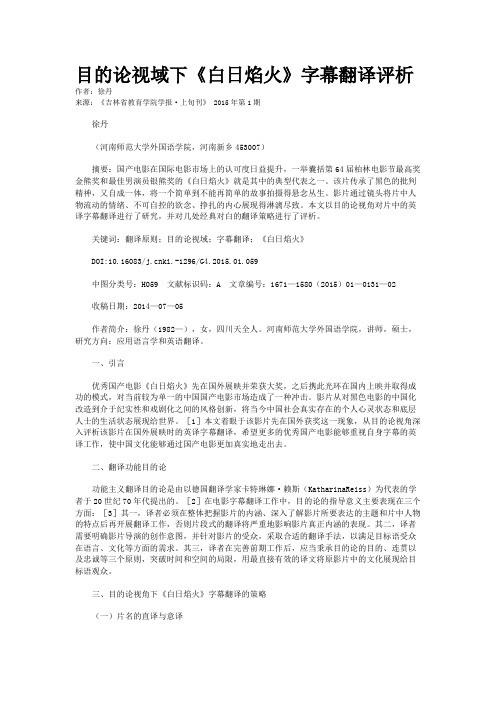
目的论视域下《白日焰火》字幕翻译评析作者:徐丹来源:《吉林省教育学院学报·上旬刊》 2015年第1期徐丹(河南师范大学外国语学院,河南新乡453007)摘要:国产电影在国际电影市场上的认可度日益提升,一举囊括第64届柏林电影节最高奖金熊奖和最佳男演员银熊奖的《白日焰火》就是其中的典型代表之一。
该片传承了黑色的批判精神,又自成一体,将一个简单到不能再简单的故事拍摄得悬念丛生。
影片通过镜头将片中人物流动的情绪、不可自控的欲念、挣扎的内心展现得淋漓尽致。
本文以目的论视角对片中的英译字幕翻译进行了研究,并对几处经典对白的翻译策略进行了评析。
关键词:翻译原则;目的论视域;字幕翻译;《白日焰火》DOI:10.16083/ki.-1296/G4.2015.01.059中图分类号:H059 文献标识码:A 文章编号:1671—1580(2015)01—0131—02收稿日期:2014—07—05作者简介:徐丹(1982—),女,四川天全人。
河南师范大学外国语学院,讲师,硕士,研究方向:应用语言学和英语翻译。
一、引言优秀国产电影《白日焰火》先在国外展映并荣获大奖,之后携此光环在国内上映并取得成功的模式,对当前较为单一的中国国产电影市场造成了一种冲击。
影片从对黑色电影的中国化改造到介于纪实性和戏剧化之间的风格创新,将当今中国社会真实存在的个人心灵状态和底层人士的生活状态展现给世界。
[1]本文着眼于该影片先在国外获奖这一现象,从目的论视角深入评析该影片在国外展映时的英译字幕翻译,希望更多的优秀国产电影能够重视自身字幕的英译工作,使中国文化能够通过国产电影更加真实地走出去。
二、翻译功能目的论功能主义翻译目的论是由以德国翻译学家卡特琳娜·赖斯(KatharinaReiss)为代表的学者于20世纪70年代提出的。
[2]在电影字幕翻译工作中,目的论的指导意义主要表现在三个方面:[3]其一,译者必须在整体把握影片的内涵、深入了解影片所要表达的主题和片中人物的特点后再开展翻译工作,否则片段式的翻译将严重地影响影片真正内涵的表现。
《白日焰火》中英片名从虚到实的顺应
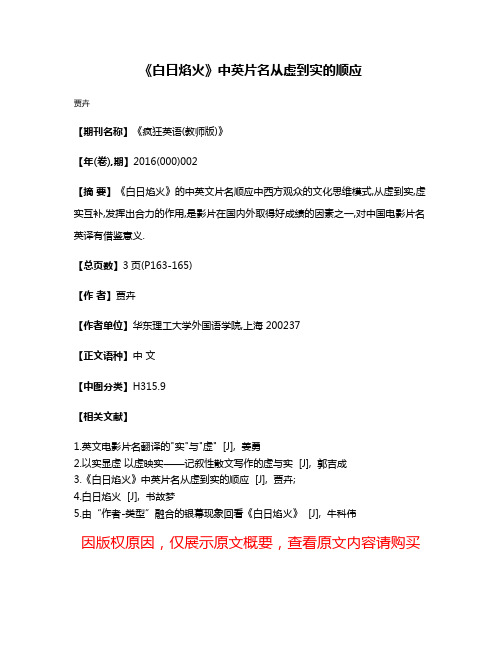
《白日焰火》中英片名从虚到实的顺应
贾卉
【期刊名称】《疯狂英语(教师版)》
【年(卷),期】2016(000)002
【摘要】《白日焰火》的中英文片名顺应中西方观众的文化思维模式,从虚到实,虚实互补,发挥出合力的作用,是影片在国内外取得好成绩的因素之一,对中国电影片名英译有借鉴意义.
【总页数】3页(P163-165)
【作者】贾卉
【作者单位】华东理工大学外国语学院,上海 200237
【正文语种】中文
【中图分类】H315.9
【相关文献】
1.英文电影片名翻译的"实"与"虚" [J], 姜勇
2.以实显虚以虚映实——记叙性散文写作的虚与实 [J], 郭吉成
3.《白日焰火》中英片名从虚到实的顺应 [J], 贾卉;
4.白日焰火 [J], 书故梦
5.由“作者-类型”融合的银幕现象回看《白日焰火》 [J], 牛科伟
因版权原因,仅展示原文概要,查看原文内容请购买。
- 1、下载文档前请自行甄别文档内容的完整性,平台不提供额外的编辑、内容补充、找答案等附加服务。
- 2、"仅部分预览"的文档,不可在线预览部分如存在完整性等问题,可反馈申请退款(可完整预览的文档不适用该条件!)。
- 3、如文档侵犯您的权益,请联系客服反馈,我们会尽快为您处理(人工客服工作时间:9:00-18:30)。
第32卷第4期2017年8月Vol.32No.4Aug.2017景德镇学院学报Journal of Jingdezhen University 一、研究背景及《白日焰火》简介随着世界经济文化一体化的进程,各国之间跨文化交流日益增多。
作为文化载体,影视剧逐渐成为跨文化交流的重要组成部分。
随着影视业的蓬勃发展以及翻译研究的逐步深化,电影字幕翻译日益受到国内学者的重视。
笔者通过在中国知网数据库的文献搜索当中以“影视字幕翻译”为关键词,搜索到大量与此相关的文章。
笔者发现,电影字幕研究已由早期的粗略探索逐渐发展到如今的具体化多样化的探索。
如:张春柏的《影视翻译初探》(1998),李和庆、薄振杰的《规范与影视字幕翻译》(2005)都属于早期对电影字幕翻译的粗略研究,并未与某个具体翻译策略理论相联系或以对某部电影进行专业分析。
随着各种翻译理论的发展,电影字幕翻译进入到一个相对较深层次。
电影字幕翻译所涉及的学科和理论也愈加广泛,包括:传播学、语言学、跨文化交流学等学科及目的论、关联理论、接受理论、互文性理论、功能对等论、语言顺应论等理论。
笔者同时发现,大多数的文献资料都是期刊或论文,而相对的著作较少。
且大多数的研究都是以某部外语片为体裁,研究电影字幕英译汉的策略理论。
因而,笔者对国内目前电影字幕翻译的淤收稿日期:2017-03-13作者简介:王键雄(1985-),男,福建福州人。
助教,硕士,主要从事影视剧字幕翻译方向研究。
王键雄①(福建农林大学东方学院,福州350001)摘要:随着跨文化交流的加深,国内外影视剧的传播也日渐增多。
影视作品交流已成为中外文化交流中的重要组成部分,因此,影视作品字幕翻译的重要性得以显现。
本文以目的论三原则即“目的原则、忠实原则、连贯原则”为理论基础,讨论在目的论三原则指导下的电影字幕翻译,并以获2014年第64届柏林国际电影节最佳影片金熊奖和最佳男演员银熊奖的《白日焰火》为例,为进一步推动华语电影融入世界文化,影视剧中译英研究提供参考。
关键词:电影;目的论三原则;字幕翻译;《白日焰火》中图分类号:J955.3文献标志码:A文章编号:2095-9699(2017)04-0027-06从目的论三原则看电影字幕翻译———以《白日焰火》为例研究现状总结如下:第一,学术论文较多,研究专著匮乏。
第二,研究方向大多为西片中译,中片西译的研究较少。
第三,研究视角日益丰富,理论研究逐渐发展。
第四,对于电影字幕翻译与其他学科相结合的研究,有待进一步更加细致、深入的研究。
本文将以《白日焰火》为例,从目的论三原则角度出发探讨电影字幕翻译。
《白日焰火》()上映于2014年3月,是一部国产悬疑爱情影片。
该影片在2014年第64届柏林国际电影节上获得最佳影片金熊奖及最佳男演员银熊奖,同时也是第五部获得金熊奖的华语电影,廖凡借此片成为第一个获得柏林影帝的华人演员。
影片讲述了,落魄警察张自力(廖凡饰)因为查案,爱上了命运多舛的寡妇吴志贞(桂纶镁饰)。
而吴志贞在洗衣店打工时,因为弄坏了顾客的皮衣,无力偿还,被客人要挟用肉体赔偿皮衣,从而让其心生杀意,最后失手将对方杀死。
而吴志贞的丈夫梁志军(王学斌饰),因太爱自己的妻子,身为煤炭公司过磅员的他帮助妻子将尸体碎尸,并通过运煤的火车,分发到全国各地,让第一现场消失得无影无踪。
最后为了帮助妻子逃脱罪名,将自己作为替身,假死于世间,过着活景德镇学院学报2017年第4期死人的生活,只能对妻子的生活默默关注。
影片的最终画面,吴志贞在一个寒冬的白天被押往原来的住所指认现场,在离开的路上张自力从附近的建筑上施放焰火。
二尧目的论与字幕翻译1.目的论概述功能目的翻译理论的形成大体经历了四个阶段,其颇具里程碑意义的理论是莱斯的功能主义翻译批评理论(functional Category of Translation Criticism)、费米尔的目的论及其延伸理论(Skopotheorie and Beyond)、曼塔利的翻译行为理论(Theory of Translation Action)、和诺德的功能加忠诚理论(Function plus Loyalty)。
早在1971年,莱斯的《翻译批评的可能与局限》(Possibilities and Limits of Translation Criticism)被认为是德国翻译学术研究的起源。
她提出三大功能文本类型,即“信息型”(重内容),“表达型”(重形式),“诱导型”(重诱导)。
同时在对等理论的基础上,莱斯以文本功能为标准创建了一种翻译批评模式,该模式主要是建立在源语言语篇和目标语语篇之间的功能关系的基础上。
[1]费米尔在导师莱斯对等理论的基础上,创立了目的论。
目的论认为,任何形式的翻译行为包括翻译本身都是一种有目的的行为。
[2]翻译是以预期的受众为导向,即为目标环境中的目标语目的和目标语受众创造一个文本。
[3]芬兰翻译理论学家曼塔利以行为理论准则为基础,提出了翻译行为理论。
该理论以涵盖所有跨文化转换,包括不涉及源语言语篇和目标语语篇的跨文化转换为旨归。
[4]曼塔利将翻译行为定义为:产生某一特定信息传递媒介,为协调行为合作和交流合作的高级行为系统服务的过程。
诺德认为“翻译并不是复制源语篇,而是在对源语篇的信息来源做选择性处理的同时,在目标语文化中的功能性的再创作。
”[5]由于源语篇作者、目标语受众和译者的翻译目的可能各不相同,因此,译者有责任在传统的对等翻译理论与彻底的功能主义翻译法中进行协调,从而达到所要求的翻译目的。
[6]2.目的论三原则在翻译目的论中,翻译必须符合三个原则,即目的原则、连贯原则、忠实原则。
所谓目的原则,即翻译行为的目的决定了翻译行为的过程、策略和结果。
[5]因此,译文在目标语情境中预期要达到的功能和目的很大程度上取决于译文的最终形态。
[7]翻译作为一种人类行为,除了行动的目的之外,还有行动的结果,这一结果就是译品,是一种“特殊形式的目标文本”。
[8]影视剧翻译的目的主要是帮助观众跨越语言壁垒,理解影片内涵,享受观影乐趣。
以下三个例子,就体现了影视剧翻译传达信息,帮助观众理解影片的目的。
例1张自力:你说那个车咋跟错了。
一个是E,一个是F,就差一横。
张自力:I had the wrong bus.F should have been “E”,not“F”.I mixed up the plates.分析:此例中,译者没有直译,而是用改译法,特别是将“就差一横”,译为“mix up the plates”。
在英文当中,没有笔画的说法,因此如果直译肯定会造成误解。
考虑到电影字幕的目的在于传达信息,译者将“就差一横”译为“mix up the plates”与前文的“had the wrong bus”形成了前后对照,实现了其译文的传达信息的目的。
例2张自力:有些事儿……我想解释一下。
吴志贞:不用解释。
张自力:我说———你别这样。
张自力:I want to explain吴志贞:No need张自力:Hear me out.Don’t be like this.分析:这段对话发生在警察内,张自力要向吴志贞解释自己接近她并不只是为了查案,而吴志贞却不愿意听他的解释。
译者将“我说”译为“Hear me out”生动地表达出张自力希望吴志贞听他解释的心情,此处改译充分传达了原文所要表达的内涵。
例3吴志贞:98年,他第一次抢劫,就失手把人杀了。
当时他怕得要死,不知怎么就想出个替身的办法,让你们永远也找不到他。
结果他把你们骗了,可自己永远也回不来了……张自力:算他运气好,那时候DNA不是哪里都28能做的。
吴志贞:he decided to fake his own death,using the victim’s corpse as his stand-in.张自力:DNA testing wasn’t widespread.分析:此例是吴志贞向张自力讲述梁志军杀人潜逃的事件。
译者将“不是哪里都能做的”译为“not widespread”,符合英语口语表达的模式,很好地表达了当时DNA检查并不普及的情况。
同时,为避免冗长累赘,将“当时他怕得要死,不知怎么就想出个替身的办法,让你们永远也找不到他”译为“he decided to fake his own death,using the victim’s corpse as his stand-in.”更加地简洁明了,传神达意,从而让观众更加顺畅地欣赏影片。
除了上述目的原则之外,翻译行为还应符合连贯原则。
连贯原则主要指的是,语内连贯,即译文本能以目标受众情景相连贯的方式来理解。
[9]在以下例子中,译者通过采用改译等翻译策略,让译文符合受众的语言习惯,来达到语内连贯的目的。
例4张自力:那算上梁志军,三个人的死都和她有关系了?小王:没错。
谁跟她好,谁倒霉。
张自力:She’s connected to three murders.小王:Every man she’s with ends up dead.例5老板:警官,这就是他刚才吃的这碗面。
老板:Here’s what is left of the noodles,officer.分析:在第一个例子中,译者采用改写策略将“三个人的死”译为“three murders”,“倒霉”译为“end up dead”,在衔接影片内容的同时,译文地道的英语表达方式,让译文更加易懂。
第二个例子将“警官,这就是他刚才吃的这碗面”译为“Here’s what is left of the noodles,officer”,因为影片画面内容是老板将食客所吃剩下的面给警察检查,所以强调的是剩下的,即“what is left”,这样的翻译更符合英语头重脚轻的表达方式,从而达到语内连贯。
例6吴志贞:我把它们撒到河里了。
刘队长:撒到河里?没留下一点?吴志贞:没有。
看见那种东西,心里会难受的。
刘队长:我想了解一下当时的情况,咱们车里说好吗?吴志贞:I delivered them in the river.刘队长:You didn’t keep any?吴志贞:No.I couldn’t stand to look at them.刘队长:I have some questions.Can we talk in the car?在此例中,译者用了省译法,省略了“撒到河里”,同时,用了改译法将“心里会难受”译为“couldn’t stand”,而不是“my heart will be broken”,此处的改译实现了英语表达中的头重脚轻。
同时,译者将“我想了解一下当时的情况”译为“I have some questions”,这比“i want to know what happened”更符合英文口语的表达方式,同时也符合影片警察询问吴志贞的情景,这样的语内连贯让观众有观看母语影片的感觉。
